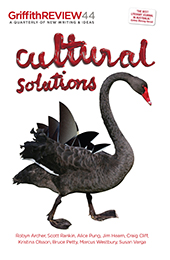Featured in

- Published 20140506
- ISBN: 9781922182258
- Extent: 264 pp
- Paperback (234 x 153mm), eBook

Already a subscriber? Sign in here
If you are an educator or student wishing to access content for study purposes please contact us at griffithreview@griffith.edu.au
Share article
More from author

Not another diversity panel
EssayWHAT I WANT is for three people to speak to you. Merlinda Bobis, Julie Koh and Mammad Aidani. You may know one of them, three...
More from this edition

A story in clothes
GR Online'Her pale draperies, and the background of foliage against which she stood, served only to relieve the long dryad-like curves that swept upwards from...

Not for me
MemoirI HAD SEEN the flyers around. 'Come and try theatre, learn writing and performance skills in a supportive environment.' Stupid. Embarrassing. A waste of money. A waste of...

Interview with
Craig Cliff
Interview Craig Cliff is a Wellington-based writer. His short story collection, A Man Melting, won the Best First Book in the 2011 Commonwealth Writers' Prize, and...